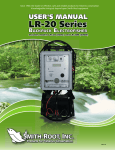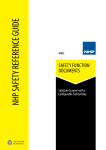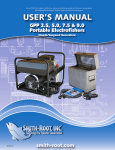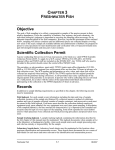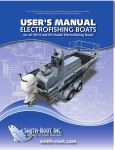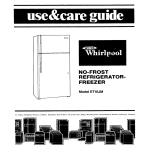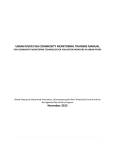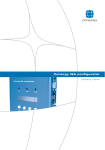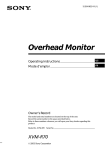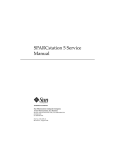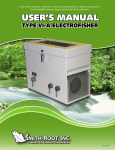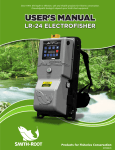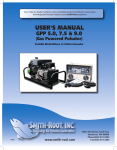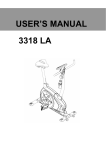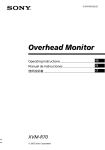Download - Smith-Root
Transcript
Since 1964, the leader in effective, safe and reliable products for fisheries conservation. Knowledgeable biologists depend upon Smith-Root equipment. USER'S MANUAL LR-20B SMITH-ROOT, INC. Includes model LR-20 (200w) Products for Fisheries Conservation WWW.SMITH-ROOT.COM 09441.04 USER'S MANUAL LR-20B Backpack Electrofisher Operation and maintenance Contents Introduction....................................................................... 1 Overview............................................................................ 2 Controls & Connectors..................................................... 4 Packframe.......................................................................... 6 Cable Strain Relief Clips.................................................. 7 Operation........................................................................... 8 Safety Features.................................................................. 9 Electrofishing Safety....................................................... 11 Battery Care & Maintenance......................................... 13 Battery Maintenance & Diagnostic equipment............ 19 Electrode Pole Testing..................................................... 20 Cathode Testing............................................................... 21 Electrode/Cathode Tester............................................... 21 LR-20B Operation Hints................................................ 22 Cleaning & Maintenance................................................ 22 Model 12/15 Settings Chart............................................ 23 Specifications................................................................... 24 Items manufactured by companies other than Smith-Root carry the original manufacturer’s warranty. Please contact product manufacturer for return instructions. All Smith-Root, Inc. manufactured products are covered by a one-year warranty. Credit & Refund Policy: Customers returning equipment, in new condition, will be given credit within five days from the date of the return. A return authorization must accompany returns. Valid equipment returns include, but are not limited to, ordering incorrect equipment, funding deficits, and defective equipment returned for reimbursement. All returns are subject to a restocking fee and applicable shipping charges. The restocking fee is figured at 10% of the purchase price but not less than $20.00. Customers receiving equipment in damaged condition will be referred to the shipping company for insurance reimbursement. 09441.04, © 2012 Smith-Root, Inc. Vancouver, WA - USA • 2011 I LR-20 LR-20B BACKPACK ELECTROFISHER & Introduction The LR-20 Backpack Electrofisher offers the safety and ruggedness of the LR-24 with the reliability of our classic Model 12, while using the accessories of our standard LR-24. The LR-20B is an ideal transitional unit from our classic Model 12; it shares many conventions as well as the safety and reliability and accessories of the LR-24. Use them for light-duty electrofishing or in conjunction with LR-24 units for wider field applications. The LR-20B is a good addition to your collection of Electrofishers in order to cover all field conditions. SAFETY FEATURES: • Emergency shut-down switch disables the unit • Flashing red output warning light THE LR-20B Combo Consists of: 1 - Electrode Pole 6' 2PC................................07575 • Tilt sensor • Water immersion turns output off 1 - 11" Aluminum Electrode Ring...................03297 • Electrode out of water output off 1 - Rattail Electrode........................................06821 • Pole mounted operator switch 2 - 24V 7 Ah Battery......................................06681 • Non-conductive case 1 - UBC-24 Battery Charger (USA).................06815 • Quick release shoulder harness and waist belt 1 - Case w/Wheels & Retractable Handle.......09540 1 • Audible output warning system www.smith-root.com USER'S MANUAL Overview Controls and Features Take the time to familiarize yourself with the LR-20's features before beginning electrofishing. Timer Reset Pack Frame Duty Cycle Output Frequency Cover Latch Emergency Shutdown Switch Lcd Display Voltage Range Switch Audio Alarm Warning Light Cover Latch Sensor Immersion Sensor Harness Cathode Connector Anode Connector 24v Battery Control Connector Battery Connector 2011 2 LR-20 LR-20B BACKPACK ELECTROFISHER & OVERVIEW (Cont.) Output Frequency- controls the output frequency or pulses per second of the electrofisher. V O L T S Duty Cycle- Controls the percentage of time the output pulse is on out of the time from the start of one output pulse to the start of the next output pulse. DUTY CYCLE Timer Reset- Resets the seconds counter display to zero. FREQUENCY LCD Display- Shows the number of seconds the output of the unit has been active since the last timer reset, the peak output voltage and current, the average battery voltage and current, a fuel gauge type display of the battery voltage, heatsink temperature and waveform settings. Duty cycle and Output Frequency V O L T S DUTY CYCLE Audio Alarm- Provides loud audio warning whenever 30 volts or more are present between the anode and cathode and also when the unit is first switched on. PERIOD OUTPUT CONTROL 40 35 30 25 20 45 50 60 35 40 45 70 50 30 80 25 60 90 20 70 100 15 80 2 PULSES 110 10 15 10 120 3 PULSES 5 DC GATED BURST FREQUENCY Warning Light- Flashes once per second whenever 30 volts or more are present between the anode and cathode and TIMER also when the unit is first switched on. PUSH Emergency Shutdown Switch- Turns unit on when the red cover and switch are in the up position. Also serves as an emergency shutdown switch by means of red flipdown cover. TO RESET DUTY CYCLE Clockwise: LCD display; Power/ Emergency Shutdown Switch; Output Frequency and Duty Cycle switches; Cover Latch. LR-20 Electrofisher v.0.22 Smith-Root, Inc. www.smith-root.com Voltage Range Switch- Controls the output voltage of the VOLTAGE RANGE electrofisher. Voltages between 50 and 990 volts may be selected. 250 0 25 2 00 500 100 700 400 500 700 990 990 LR-20 Anode Connector - Provides the high voltage connection for the anode electrode. Backpack Electrofisher ATTENTION: FRONT COVER MUST BE CLOSED FOR UNIT TO OPERATE Left to right: Cathode connector; power cord; control connector; anode connector. 3 50 350 500 50 50 Control Anode 350 400 Immersion Sensor - Automatically turns the output off when water bridges the sensing contacts. 0 10 100 300 300 35 0 70 0 150 150 CATHODE 300 150 400 200 Cathode Power 250 200 ANODE Connector- Provides the low voltage control Control connection to the pole switch. CONTROL Cathode Connector- Provides the high voltage connection to the cathode electrode. Battery Connector- Provides power to the unit from the battery. Cover Latch and sensor- Two over-center toggle latches secure the front cover. Cover must be closed and latched before the output of the unit can be activated. www.smith-root.com 990 USER'S MANUAL Controls & Connectors External Controls, Connectors and Sensors ON/OFF SWITCH: Located on the right side of the electrofisher under the red emergency off cover. To turn the unit on, raise the cover and push the switch up to the on position. To turn the unit off, press down on the red emergency off cover. ANODE CONNECTOR: Located on the bottom right corner of the electrofisher the large black 2 socket connector provides the high voltage connection for the anode electrode. This connector has a locating lug that assures the anode pole can only be connected one way. The proper connection for the anode pole is with the cable pointing away from the backpack. BATTERY POWER CONNECTOR: Located on the bottom left center of the electrofisher this red and black color coded connector provides power to the unit from the battery*. To connect a battery to the electrofisher, match the colors on the battery connector to the colors on the battery's connector, red to red and black to black**. * C A U T I O N : Before connecting or disconnecting a battery to the unit, make sure the power switch is in the off position, failure to do so may cause damage to the battery and the electrofisher. **WARNING: Reversing the connectors will damage the electrofisher and may cause serious injury or death. CATHODE CONNECTOR: Located on the bottom left corner of the electrofisher the large black 2-socket connector provides the high voltage connection to the cathode electrode. This connector has a locating lug that assures the cathode can only be connected one way. The proper connection for the cathode is with the cable pointing away from the backpack. CONTROL CONNECTOR: Located on the bottom right center of the electrofisher the small black 4-socket connector provides the low voltage control connection to the pole switch. This connector has a locating lug that assures that the control connector can only be connected one way. The proper connection for the control connector is with the cable pointing away from the backpack. IMMERSION SENSOR: Located on the bottom left corner of the enclosure behind the cathode connector. The output of the electrofisher is automatically deactivated when these contacts come in contact with water. NOTE: Although the immersion sensor is located above the battery tray of the LR-20, do not submerge the battery; doing so will cause damage to the battery and the electrofisher. FRONT COVER: The clear window cover of the control panel allows easy observation of the controls and display. To open the cover, release the over-center latches at the top and bottom right corners of the electrofisher. NOTE: The front cover must be closed and latched before the output of the unit can be activated. 2011 4 LR-20 LR-20B BACKPACK ELECTROFISHER & CONTROLS & CONNECTORS (Cont.) Front Panel Controls and Indicators TIMER RESET: Located on the upper right corner of the front panel. This switch allows the user to reset the 6 digit seconds timer back to 0. OUTPUT CONTROL FREQUENCY DUTY CYCLE 70 30 80 25 90 20 100 15 110 10 15 10 120 5 DC 50 60 70 80 2 PULSES 3 PULSES PUSH TO RESET GATED BURST LR-20 Electrofisher v.0.22 Smith-Root, Inc. www.smith-root.com Frequency: Located on the upper left of the front panel. This switch controls the output frequency or pulses per second of the electrofisher. When the duty cycle switch is set to DC, Gated Burst 2 pulse or Gated Burst 3 pulse, this switch has no effect on the output of the electrofisher. VOLTAGE RANGE 500 2 00 400 250 300 350 2000 300 35 400 0 500 150 25 100 700 50 990 0 10 70 0 150 Display: Located in the top center of the front panel. The display shows the number of seconds the output of the LR-20 has been active since the last timer reset, the output voltage and current and a fuel gauge type display of the battery voltage. The backlight of the LCD display is always on when the electrofisher is on; this allows easy viewing of the display even in deep shadows without the need to open the front cover and turn on another switch. 35 40 45 40 35 30 25 20 Duty Cycle: Located on the upper left center of the front panel. This switch controls the percentage of time the output pulse is on out of the time from the start of one output pulse to the start of the next output pulse. When the duty cycle is set to DC, the electrofisher puts out a constant DC voltage determined by the voltage range switch. TIMER 45 50 60 50 9 90 Backpack LR-20 Electrofisher ATTENTION: FRONT COVER MUST BE CLOSED FOR UNIT TO OPERATE CATHODE CONTROL ANODE LR-20/LR-20B FRONT PANEL - Top to bottom, left to right: Frequency, Duty Cycle knobs; Timer Reset Button; Display Window; Voltage Range Switch; Audio Alarm; Warning Light. Voltage Range Switch: Located on the left side of the front panel. This 11-position switch controls the output voltage of the electrofisher. Voltages between 50 and 990 volts may be selected. Warning Light: Located in the bottom center of the front panel. Wide viewing angle, high brightness red LED's flash once per second whenever 30 volts or more are present between the anode and cathode and also when the unit is first switched on. Audio Alarm: Located on the right side of the front panel. A high volume audio alarm with volume shutters provides additional warning whenever 30 volts or more are present between the anode and cathode. In addition, the beep rate gives an indication of the power being drawn by the unit. It also sounds when the unit is first switched on. 5 www.smith-root.com USER'S MANUAL BATTERY INSTALLATION BATTERY INSTALLATION AND SAFETY BATTERY INSTALLATION To ensure operator and unit safety, as well as the life of the battery, care must be taken to make sure that the battery is installed correctly. The easiest way to install the battery is to place the electrofisher on the ground (or similar safe, dry surface), rather than on the operator's back. A.Start by placing the LR-20B on the ground, orienting the battery inside with its bottom on the wall towards the packframe and centering it towards the bottom. B.Lay the battery inside the battery tray handle up, so that the power connectors are closest to the control box. C.The handle should fit inside the corresponding notch in the front of the tray. Pass the battery strap through the oval handle cutout and secure the clasp while taking up any slack in the strap. It should be snug and not allow the battery to move. 2011 6 LR-20 LR-20B BACKPACK ELECTROFISHER & PACKFRAME Packframe The packframe allows for various positions of the shoulder straps and waist belt to fit most people. The straps and belt all have quick release latches that allow the Electrofisher to be removed quickly if the operator falls into deep water or becomes injured*. Shoulder Strap Adjustment Shoulder Strap Chest Strap Quick Release Padded Waist Belt Pack Frame Waist Belt Quick Release *WARNING: Always unfasten the chest strap of the pack before crossing or entering the water. Should you fall into deep water, the chest strap may prevent you from removing the electrofisher quickly. 7 www.smith-root.com USER'S MANUAL QUICK RELEASE PACKFRAME QUICK RELEASE - STRAIN RELIEF Quick release system It may be necessary in some circumstances to remove the electrofisher backpack quickly. The LR-20 has an integral quick release pack frame. Just press the latch tabs on the waist belt (1) and shoulder straps (2) and the entire unit falls away. The following procedure illustrates how the quick release system is designed to work: 1.Squeeze the release tabs on hip belt buckle to remove hip belt. 2.Squeeze the release tabs on either shoulder strap. 3.With strap detached, shrug off opposite shoulder strap. 4.This will allow the pack to fall away from you very quickly! Move away from pack as it falls. Cable Strain Relief Clips Fig. 1 - Location of rings Fig. 2 - Right side Fig. 3 - Left side These clips are designed to prevent the anode and cathode cables from traveling beyond their recommended range of motion and to relieve undue strain on the connector plugs. Make sure that the ring-mounted swivel clip on either side of the packframe is attached to the electrode cables as shown in Figs. 1-3. Using the rings and clips in the manner indicated will transfer the weight of the electrode cables to the packframe and offset the possibility of damaging either cable or their respective connectors. WARNING: Without Cable Strain Relief Clips, the anode and cathode connectors or their cords could become damaged. 2011 8 LR-20 LR-20B BACKPACK ELECTROFISHER & Operation Make sure the Electrode ring is clean and shiny. A cloudy, dull-gray Electrode ring will reduce your catch per unit effort and will increase the injury rate of fish. Initial setup of voltage, frequency, and duty cycle should be done outside of your sample area to avoid influencing your statistics. Picture of Switch in OFF postion Battery Connector Immersion Sensor 9 1. Make sure the power switch on the side of the control unit is in the off position (pressed down). 2. Attach the anode and cathode to their output connectors. 3. Attach the smaller connector on the anode cable to the control connector of the unit. 4. Be sure you know the location of the quick release buckles for the backpack, and unlatch the chest strap before entering or crossing the water. 5. Check with each crew member to be sure they know you are ready to turn on the power. 6. Connect the battery. 7. Turn on the power. Do not press the anode switch. Check the operation of the tilt switch by bending forward until the tilt switch activates, (about 55 degrees), and the tilt message appears on the display. Straighten up and the status display should return. If the tilt message does not appear, do not use the electrofisher; send it to Smith-Root for repair. 8. Place a dampened cloth on the immersion sensor contacts located on the lower left-hand corner of the control unit's box, behind the cathode connector. The display should show the immersion warning. When the cloth is removed and the power is turned off and back on, the display should return to the status screen. If the immersion message does not appear, do not use the electrofisher; send it to Smith-Root for repair. www.smith-root.com USER'S MANUAL Operation OPERATION (Cont.) Set the frequency, duty cycle, and voltage switches to the values you wish to use. If you don't know what values to use, set the switches as shown below and follow the procedure in the next step. NOTE: The front cover of the electrofisher must be closed to activate the output. Frequency 15 Hz. Voltage 50 volts. TIMER 45 50 60 35 40 45 70 50 30 80 25 60 90 20 70 100 15 80 2 PULSES 110 10 15 10 120 3 PULSES 5 DC GATED BURST FREQUENCY PUSH TO RESET DUTY CYCLE LR-20 Electrofisher v.0.22 Smith-Root, Inc. www.smith-root.com Duty cycle 10 percent. 400 250 300 350 2000 300 35 400 0 500 150 25 100 700 50 990 500 150 0 10 10. Duty cycle and frequency can have a huge impact on taxis. Do not be timid about changing these settings. In general, lower frequencies are safer for larger fish than higher frequencies. If you are not getting any response from fish at all, then change the settings as follows: VOLTAGE RANGE 70 0 OUTPUT CONTROL 40 35 30 25 20 2 00 9. 50 990 Backpack LR-20 Electrofisher ATTENTION: FRONT COVER MUST BE CLOSED FOR UNIT TO OPERATE a. Increase the voltage switch one position, and try again. Stop increasing voltage when you begin getting a forced response (twitch) from the fish when you press the anode pole switch. b. If fish are not showing taxis, then increase the duty cycle switch one position, and try again. If necessary, repeat this step until you elicit taxis in the fish. If you increase the duty cycle to maximum and still are not getting taxis, then reduce the duty cycle back to 10% and go to the next step. c. Increase the frequency switch one position, and try again. If necessary, go back to step “a” before increasing frequency again. 2011 CATHODE CONTROL ANODE Front Panel details OFF ON Electrode Pole Safety Switch 10 LR-20 LR-20B BACKPACK ELECTROFISHER & Safety Features Audio Alarm Emergency Shutdown Switch The audio alarm indicates 2 different operating conditions: EMERGENCY 1. Presence of high voltage in the water: Whenever the anode and cathode are in the water and more than 30 volts is present while the unit is on, there will be an audible tone emitted by the alarm. ON SHUT DOWN 2. Average power output level: OFF The red flip-down toggle switch located on the right side of the control unit is the Emergency Shutdown Switch. This switch is also the main on/off switch for the Electrofisher. To turn the 09588 Shutdown Switch 3.25 X 3.25” (1 ea.) power on, the user must lift the red cover upwards and manually flip the exposed toggle switch to the up position. Since the red cover must first be lifted, it helps to prevent accidentally powering up the unit. Flipping the red cover down will immediately turn the unit off. 09588 From 50 to 99 watts the audio tone pulses twice per second. From 100 to 149 watts the audio tone pulses three times per second. From 150 to 200 watts the audio tone pulses four times per second. Pack Frame Quick Release The LR-20 and LR-20B have an integral quick release pack frame. Simply lift one of the two tabs on the shoulder straps while unlatching the waist belt and shrug the entire unit away. Flashing Red Light Audio Alarm Flashing Red Light Bright, long-life LED lamps flash whenever the unit is turned on and 30 volts or more is present between the anode and cathode. 11 From 0 to 49 watts the audio tone pulses once per second. CAUTION!: Always unlatch the chest strap of the pack before entering or crossing water. If left latched, this strap may prevent the user from quickly removing the LR-20B in the event of an emergency, such as falling into deep water. www.smith-root.com USER'S MANUAL Safety 2011 12 LR-20 LR-20B BACKPACK ELECTROFISHER & ELECTROFISHING SAFETY SAFETY QUICK LIST 1. At least two members of the crew must have current first aid and CPR cards. 2. Make sure every member of your crew knows where the nearest hospital is and how to get there or where to go to get help. 3. All members of the crew should have completed an electrofishing course. 4. 5. 6. 7. Before loading up equipment and heading into the field, make sure every member of the crew knows your evacuation routes in case of an accident. Check the equipment for damaged or missing parts and for proper operation. Never use an electrofisher that is in poor condition or not working correctly as it can present a severe shock hazard. Check the cathode cable for wear and burrs that may cause injury or tear holes in protective clothing. Check the insulation for damage. Replace the cathode as necessary. Check the anode pole for cracks in the fiberglass and handle assembly. Replace as necessary. 8. Check the curl cord for cracks and abrasion. Do not use a cracked pole or a pole with a damaged curl cord. 9. Check your boots and high voltage gloves for holes. Boots and gloves must be watertight and without any holes. Repair or replace as necessary. 10. If you are using chest waders, you should use a wading belt. 11. Check all batteries for damage. Never use a damaged battery, as the gelled electrolyte in these batteries is a strong acid and can cause severe chemical burns and damage clothing and the electrofisher. 12. Use only dip nets with non-conductive handles. Never use an anode as a net as it is extremely dangerous to other members of the crew and can cause severe injury to any fish caught with it. 13. Never electrofish alone. 14. Never electrofish when you are tired. 13 www.smith-root.com USER'S MANUAL Safety Electrofishing Safety (Cont.) SAFETY DO'S AND DON'T'S Do’s: 1. Always be sure that all personnel are clear of the electrodes before turning on the power. 2. Know how to administer first aid treatment for electrical shock. 3. Wear flotation devices. 4. Have electrical circuits checked only by qualified technicians. 5. Disconnect the power supply when the electrofisher is not in use. Don’ts: 1. Don’t electrofish alone! 2. Don’t continue to electrofish if your boots or gloves get wet inside. 3. Don’t operate an electrofisher if you have had any prior heart ailments. 4. Don’t electrofish when you are tired. 15. Never try to reach into deeper pools with the electrodes. If you can’t safely wade in an area, it cannot be electrofished with a backpack electrofisher. 16. Only one person on a crew can order the power for the electrofisher to be turned on, and that person is the crew leader. The crew leader is responsible for the safety of everyone on the crew. 17. Any member of the crew can call for or turn off the power to the electrofisher. 18. If an accident occurs, stop electrofishing and turn off the power to the Electrofisher. The person wearing the backpack Electrofisher should leave the water and take the Electrofisher to shore. The remaining members of the crew should help or attend to the accident victim. Get help for the injured person if necessary. Evaluate what happened and make the necessary procedural or equipment changes before proceeding. 19. Never electrofish with spectators on shore. Electric fields can travel large distances through buried pipes, metal culverts, and metal sheet piling. If spectators show up during electrofishing, stop the operation and explain what you are doing. Explain the risks to them being there and ask them to please leave for their own safety. If they refuse to leave, stop electrofishing, load your equipment, and leave the area. 20. WARNING: Operating this equipment in a manner not specified in this manual or with accessories not approved by Smith-Root, Inc. may impair the protection offered by the equipment 2011 14 LR-20 LR-20B BACKPACK ELECTROFISHER & Electrofishing Safety (Cont.) ELECTRICAL SHOCK It is the current that passes through the human body that does the damage. The voltage is relevant, because it is the force that “pushes” the current through the body. Experiments show that 20 to 500 Hz AC current is more dangerous than DC, or higher frequencies of AC. The voltages used by electrofishing gear cause can death by one of three means: Ventricular Fibrillation Ventricular fibrillation is uncoordinated contraction of the muscles of the heart. The heart quivers rather than beats. Electrical current through the chest can cause this condition. Once a person goes into ventricular fibrillation, the only way to stop the quivering is to use a defibrillator that applies a pulse shock to the chest to restore heart rhythm. Cardiopulmonary resuscitation may help to keep a victim alive until he can be defibrillated. Respiratory Arrest The respiratory center is at the base of the skull. Thus, shocks to the head can cause the breathing to stop. Artificial respiration by the mouth-to-mouth method should be used in this case. Asphyxia Asphyxia is caused by contraction of the chest muscles. When a current is above a certain level, a person cannot let go of an electrically hot wire. Currents above this level may not cause ventricular fibrillation but may be enough to cause contraction of the chest muscles. If the current is not stopped, or the victim is not removed from the point of electrical contact, asphyxia will result. Artificial respiration or cardiopulmonary resuscitation may be necessary. 15 PREVENTING ELECTRICAL SHOCK Electricity needs to have a complete electrical circuit in order for current to flow. The only way that you can get shocked is if you become the electrical conductor to complete the circuit. The current flows from the cathode to the anode through the water. The water is the electrical conductor. If you touched both the anode and the cathode you would become an electrical conductor and complete the circuit path and get a severe electrical shock. If you touch only one of the electrodes, you would not complete the electrical circuit and not get shocked. WARNING: Touching any electrode is not recommended. Unless all conductive objects you come into contact with are connected to the same electrode, you will be shocked to find a current path that is not obvious, e.g., the water, or the boat. Preventing electrical shock means preventing electrical current from entering and flowing through parts of the body. The skin is a partial but variable barrier because it offers resistance to the passage of electrical current. Tough skin has more resistance than tender skin, and dry skin more than wet skin. But tough, dry skin alone does not offer enough protection for electrofishing. Rubber lineman’s gloves rated 1,000V minimum should always be worn. Even while wearing rubber gloves and waders, never touch an electrode while the circuit is energized. Do not work on the electrical system while the generator is running. Do not enter the water while the current is on during boom shocking operations. A severe electrical shock from electrofishing gear may result in the need for artificial respiration; therefore, it is imperative that no one ever works alone. To prevent electrical shock, all electrical equipment should be carefully inspected before each field operation. With all electrical equipment in good operating condition, and all insulation, junction boxes, bonding, and connections intact, there is much less danger of receiving an electrical shock. www.smith-root.com USER'S MANUAL Batteries BATTERY CARE AND MAINTENANCE 2011 16 LR-20 LR-20B BACKPACK ELECTROFISHER & Battery Care and Maintenance Charger Description The UBC-24 Battery Charger is designed to charge Batteries for the LR-24, LR-20 Series (and earlier Smith-Root 24V models) Electrofisher Systems. The UBC-24 is a truly automatic charger tailored for maintenancefree batteries as well as other types of lead acid batteries. UBC-24 Specifications Input.................. 120 Volts AC 60Hz, 200 VA Output..........................................5A DC 24V Dimensions............. 6.5"W x 5.25"H x 6.0"D Weight.................................................9.5 lbs. UBC-24 Charger....04954 The UBC-24 has a fully automatic, three stage charge sequence with an electronically timed routine and a desulfation mode. Stage 1 - Constant Current Mode. The charger starts with maximum current until the battery reaches a preset voltage. Stage 2 - Timed Constant Voltage Mode. The charge is electronically controlled with a fixed voltage ceiling which prevents excess battery gas emission and over-charging. Stage 3 - Float/Standby Mode. In this mode a fixed ceiling of 2.3 volts per cell will be maintained by monitoring and replacing battery standing losses as necessary. Full electronic protection is provided against short circuit and reverse battery connection. READ THESE INSTRUCTIONS BEFORE USING THE CHARGER The battery charger is only designed for indoor use and should not come into contact with water or dust. In order to avoid overheating, the charger should not be covered when it is in use. Caution: Old, sulphated batteries usually have a reduced capacity and are difficult to charge. The charge current will fall quickly as if the battery had received a full charge. Even though a battery in this condition should be replaced, it will retain a small charge. If mounted in a vehicle, the charger can only be used when the vehicle is not in use. 17 Chargers filled with molding material are splash-proof, but must not be immersed in water over long periods of time. The mains socket should be easily accessible. If an operational error occurs, the plug should be immediately removed from the socket. The charger contains dangerous voltages and the cover should not be removed. All service or maintenance work should be carried out by qualified personnel who can get assistance by contacting the manufacturer’s agent. A fuse protects the product against short-circuiting and overloading. The charger is designed for charging lead batteries. For safety reasons, individual battery types should have a minimum capacity. Recommended battery capacity: 6V 4-12Ah, 12V 3-12Ah, 24V 1.5-12Ah. Contact the battery manufacturer for the specific battery. Do not attempt to charge batteries that are not rechargeable. www.smith-root.com UBC-24 USER'S MANUAL Battery Under Test Battery Care and Maintenance (cont.) HOW TO CHARGE BATTERIES BAT-01 1. The charger and battery should be placed in a well-ventilated area during charging. 2. Do not connect the charger to the mains before it is connected to the battery. 3. Verify that the polarity is correct and connect the charger cable: Red to red; black to black. 4. Connect the charger to the mains. 5. When charging is finished, disconnect the charger from the mains before you disconnect the charge from the battery. WARNING: Explosive gases can arise while charging. Avoid sparks and open flames. Verify that there is adequate ventilation while charging. The charger should not be used in the vicinity of flammable gases. Avoid chargers with plastic casing coming into contact with oils, grease, etc., as most types of plastic can be broken down by chemicals and solvents. WARNING Explosive gases can arise while charging. Avoid sparks and open flames. Verify that there is adequate ventilation while charging. The charger should not be used WARNING in the vicinity ofCHARGE flammable anesthesia gases. Avoid chargers with plastic casing LED’s INDICATE FOLLOWING STATUS Explosive gases can arise while charging. Avoid sparks and open flames. Verify WARNING coming into contact with oils, grease, etc., as most types of plastic can be broken that there is adequate ventilation while charging. The charger should not be used down by chemicals solvents. Explosive gases canand arise while charging. Avoid sparks and open Verify Fast charge in the vicinity of flammable anesthesia gases. Avoid chargers with flames. plastic casing that there is adequate ventilation whileetc., charging. The charger should used The charger is in constantcoming current mode. into contact with oils, grease, as most types of plastic cannot bebe broken in the by vicinity of flammable anesthesia gases. CHARGE Avoid chargers with plastic casing down chemicals and solvents. Charge current is at its maximum. LED’s INDICATE FOLLOWING STATUS coming into contact with oils, grease, etc., as most types of plastic can be broken Fast downcharge by chemicals and solvents. Final charge LED’s INDICATE FOLLOWING CHARGE STATUS charger is in constant current mode. Red The charger is in constantThe voltage mode. Charge current is at its maximum. Charge current is less than itscharge maximum. Fast LED’s INDICATE FOLLOWING CHARGE STATUS The charger is in constant current mode. Red The battery is normally 80-95% charged. Final charge Fast charge Charge current is at its maximum. The charger stays in this The mode until the current charger is incharge constant voltage mode. to charge currentdecreases mode. Red Charge current is less than its maximum. at its maximum. termination level. Final charge The battery 80-95% charged. chargerisisnormally in constant voltage mode. Red Float (Standby/Ready)The The charger stays in this mode until the charge current Final charge Charge current is less than its maximum. The charger is in standbyThe mode. decreases tonormally charge termination level. charger in constant voltage mode. The battery isis 80-95% charged. Red The battery is fully charged. The LED changes to green. Charge current is less than its maximum. The charger stays in this mode until the charge current Float (Standby / Ready) The battery is normally 80-95% charged. The charge voltage is at standby level, the charger decreases to which charge means termination level. can Red The charger is in standby mode.until the charge current stays in this mode continue to be connectedThe todecreases the battery. battery istofully charged. The LED changes to green. charge termination level. (Standby / if Ready) The charger can return toFloat rapid charging the battery islevel, used.which means the charger The charge voltage is at standby The charger is in standby mode. canbattery continue to/ Ready) be connected the changes battery. to green. Float (Standby The is fully charged. ThetoLED The charger can return to rapid charging if themeans batterythe is used. is in standby mode. The charge voltage is at standby level, which charger The battery is fully charged. The LED changes to green. can continue to be connected to the battery. 2011 which means the charger The voltage is attostandby level, The charge charger can return rapid charging if the battery is used. Charging diagram can continue to be connected to the battery. The charger can return to rapid charging if the battery is used. 18 LR-20 LR-20B BACKPACK ELECTROFISHER & Battery Care and Maintenance (cont.) Batteries The electrofisher uses a 24 volt sealed deep cycle battery. Understanding the proper care of this battery will reduce problems in the field. Batteries should never be allowed to remain in a discharged state and should be recharged as soon as possible after use. Batteries should be charged until the green lamp on the charger comes on. Fig. 7.2: 24V-12Ah Fig. 7.3: 24V-7Ah Charging Problems: Some older batteries may not charge within 24 hours. If a battery has been left in a discharged condition for a while, it may not take a charge. If you suspect that the battery has been left discharged, charge it for 48 hours and then discharge it with the electrofisher. If the battery is not taking a charge, it will not operate the electrofisher for very long. Sometimes by cycling the battery a few times it will start taking a charge again. Note that all batteries should be charged after each use even if the battery was only slightly discharged (these batteries do not have a memory). Total number of charge/discharge cycles possible varies inversely with depth of discharge on each cycle. Over-discharging or completely discharging the battery will greatly reduce the cycles possible and a battery left in a discharged condition may be ruined. For this reason, batteries should never be allowed to remain in a discharged state. Recharge as soon as possible after each use. Service Life: Batteries which have been properly maintained should last 3 to 5 years depending on ambient temperature, depth of discharge (D.O.D.) and number of cycles (for Smith-Root batteries to maintain at least 80% of original capacity, they are rated 230 cycles for 100% D.O.D., 470 cycles for 50% D.O.D. or 1100 cycles for 30% D.O.D.). Batteries which have reached this end of life condition may still be useful where shorter operating times are appropriate. Fig. 7.4: 24V-2.2Ah 24V-12AH Battery........06682 24V-7AH Bat- 19 Shipping: These batteries conform to the UN2800 classification as "Batteries, wet, non-spillable, electric storage". They conform to the International Air Transport Association (I.A.T.A.) Special Provision A67, classifying them as non-dangerous goods and are therefore exempt from the subject regulations for dangerous goods and are acceptable for transport on both cargo and passenger aircraft. Reference: I.A.T.A. Dangerous Goods Regulations, 35th Edition, Jan 1, 1994 Section 4.4, Special Provisions: www.smith-root.com USER'S MANUAL Battery Maintenance & Diagnostic Equipment Battery Tips & Precautions 1.Keep the battery charged! The most frequent cause of battery failure is not recharging after each use. 2.Heat kills batteries. Avoid storage in exceedingly warm areas. Recommended operating temperatures are between 5 and 35 degrees C (maximum - 15 to 50 degrees C). The energy available on a given discharge cycle decreases at low temperatures and increases at higher than normal temperatures. Increased temperatures increase the gradual processes of very slow corrosion which normally occur in all lead acid batteries. 3.Avoid heavy vibrations or shocks, which may cause internal damage. Foam packing is cheap insurance. 4.Avoid contact with oils or solvents which may attack the battery case (ABS plastic resin). Clean with soap and water only. 5.Do not crush, incinerate or dismantle the battery. The electrolyte contains sulfuric acid which can cause serious damage to eyes and skin. Dispose of old batteries at a battery recycler. 2011 20 LR-20 LR-20B BACKPACK ELECTROFISHER & Battery Care and Maintenance (cont.) Life Load Capacity 20 hr 0.60A 12.0Ah 10 hr 1.05A 10.5Ah 5 hr 1.95A 9.7Ah 1 hr 7.20A 7.2Ah 30 min 12.00A 6.0Ah BATTERY SPECIFICATIONS Rating: Batteries are rated at the current which will reduce the voltage per cell to 1.67 volts in 20 hours. The heavyweight battery has a 12 amp hour rating. However its life at 100 watt continuous would be only 120 minutes. As the discharge current is increased, the efficiency and relative capacity decrease. Fig. 7.5: Relative capacity of 12Ah deep cycle battery. Battery Life Each time cycle a battery it loses some of its ability to take a charge. Deep cycle batteries are capable of being charged and discharged from 100 up to 1,000 times, depending on the depth of the discharge and the type of charger used. Service life and shelf life are both adversely affected by warmer temperatures. Fig. 7.6: Discharge curves for 12Ah and 7Ah batteries. Battery Storage 3% to 6% per month. Storage temperature above 20°(68°F) should be avoided. Shelf life can be increased by storing at lower temperatures, but store at above -30°C to prevent freezing. Batteries should be fully charged before storing and should be recharged every four months. Fig. 7.7: Effect of temperature on battery life. Effects of Temperature The temperature at which a battery is used also affects the relative capacity of the battery. Figures 7.7 and 7.8 show that in cold weather the shocking time will be less and the battery will have less capacity. Fig. 7.8: Effect of temperature on capacity. 21 www.smith-root.com USER'S MANUAL ELECTRODES Battery Maintenance & Diagnostic Equipment MC-24 MAINTENANCE CHARGER The Smith-Root MC-24 Maintenance Charger (sold separately) is specifically designed for proper battery maintenance and storage. Trickle charging optimizes battery shelf life by reducing cell deterioration. Keeping batteries fully charged can greatly increase battery life. The MC-24 eliminates the hassle of shuffling batteries from shelf to charger and keeps batteries properly charged and ready for service. With the built-in battery evaluation load test function and maximum charge indicators, you can see the state of charge and condition of each battery and identify low charged and worn-out batteries. Charging batteries using the MC-24 takes between two and four days. It is also an excellent cost effective alternative to purchasing multiple battery chargers, because it can recharge four batteries at once. Fig. 8.1: MC-24 Maintenance Charger BAT-01 BATTERY ANALYSIS TOOL The Battery Analysis Tool (sold separately) operates in conjunction with the BC-24PS Battery Charger. It tests all models of 24 V backpack batteries (adaptors included) and in a clear and concise manner gives the usable battery life remaining. This tool is not to be used during each charge / discharge cycle, but rather is intended to be used a few times a year, just prior to actually using the batteries. It may also be used to accurately test any Smith-Root 24 Volt battery where the battery condition is either unknown or is questionable. In practice, The Battery Analysis Tool is plugged into a standard Smith-Root BC-24PS and also the battery under test. The battery will begin to charge as soon as the charger is plugged in (Do not use an MC-24 Maintenance Charger for this test). Fig. 8.2: BAT-01 Battery Analysis Tool From AC UBC-24 Battery Under Test BAT-01 MC-24 Maintenance Charger...........................06811 2011 Fig. 8.3: BAT-01 Battery Analysis Tool hookup 22 LR-20 LR-20B BACKPACK ELECTROFISHER & ELECTRODE POLE AND CATHODE TESTER Electrode Pole & Cathode Tester This test device allows customers using Smith-Root type LR-24, LR-20 and Model 12/15 backpack Electrofishers to test their anode poles and cathodes (rat-tails) in a simple, concise manner that requires minimal interpretation. The test device is designed to give a clear go – no go test of both anode poles and cathodes, as well as some limited indication of what is likely wrong with the item being tested. The Electrode/Cathode Tester is simple to use, and negates the need for any other test equipment (such as a volt-meter or continuity tester). It is selfcontained and except for periodic replacement of the battery requires no service or calibrations. The tests can be performed Electrode Pole/Anode pole tester by one person with no assistance. Electrode/Cathode Tester..............08115 23 Pole www.smith-root.com USER'S MANUAL SETTINGS LR-20 OPERATION HINTS Make sure the Anode ring is kept clean. Anode rings are made from aluminum and will eventually develop an oxide coating that will give the ring a dull appearance. This coating impairs the transfer of electricity from the electrode to the water and can be removed with fine steel wool. To maximize battery life, always connect batteries to their charger as soon as possible after use. Resist the temptation to put a net on Anode rings. Nets have the following very undesirable characteristics: 1. They present a safety hazard since it can place the operator's hands unnecessarily close to the electrode when removing fish. 2. The intensity of the electric field increases as the fish to electrode distance decreases. Therefore, the risk of injury to the fish is greatly increased with the use of an Anode-ring net. 3. They make the Anode ring more difficult to clean. CLEANING AND MAINTENANCE The LR-20 enclosure and suspension system may both be cleaned with warm water and a mild soap solution. Spray the solution on the area to be cleaned and then wipe with a soft cloth. CAUTION: Do not use solvents on the case of the LR-20 as they may cause permanent damage to the LR-20. Extended Maintenance Program The extended maintenance program is a service contract offered to customers who have purchased SRI electrofishing equipment directly from our factory. It can be purchased for equipment that is past its standard one-year warranty. Older equipment is subject to eligibility parameters such as hours/years in service. Our Smith-Root factory technicians will perform cleaning of internal component parts, electronic repairs and calibration once (1) per year. During this maintenance period, upgrades to current specifications will be performed to factory standards. The unit will be recertified and issued an SRI certification label. All labor and materials will be included in the yearly inspection. Contact Smith-Root, Inc. for additional information. 2011 24 LR-20 LR-20B BACKPACK ELECTROFISHER & MODEL 12-B/15-D SETTING CHART Use this chart to convert settings used with the 12-B or 15-D to settings on the LR-20. Example: If H2 were used with the model 12-B, the corresponding settings for the LR-20 would be 50Hz at 5% Duty cycle. Note that the LR-20 does not have pulse width settings. Standard Pulses Model 12-B and 15-D PULSE WIDTH V O L T S Volts Mode Switch Period Width 5 6 1Hz 2ms 3ms 4ms 6ms 7ms 8ms Frequency 1ms 2ms 3ms 4ms 6ms 8ms Period C 10Hz 500us 1ms 2ms 4ms 6ms 8ms D 15Hz 500us 1ms 2ms 4ms 6ms 8ms E 20Hz 500us 1ms 2ms 4ms 6ms 8ms F 30Hz 500us 1ms 2ms 4ms 6ms 8ms G 40Hz 500us 1ms 2ms 4ms 6ms 8ms H 50Hz 500us 1ms 2ms 4ms 6ms 8ms I 60Hz 500us 1ms 2ms 4ms 6ms 8ms Time Standard pulse DUTY CYCLE Period Between Burst = 3 pulses Volts 4 5Hz Duty cycle and Output Frequency PERIOD Burst rate = 1 Period Time Gated Burst 3 A FREQUENCY = 1 Width 2 B Pulse width x Frequency x 100 = Duty Cycle in % V O L T S 1 Gated burst J 70Hz 500us 1ms 2ms 4ms 6ms 8ms K 80Hz 500us 1ms 2ms 4ms 6ms 8ms L 90Hz 500us 1ms 2ms 4ms 6ms 8ms M 100Hz 100us 500us 1ms 2ms 4ms 6ms See diagrams at left for an explanation of Duty Cycle, Output Frequency and Gated Bursts. Duty Cycle Percent LR-20/LR-20B Frequency 25 5 10 15 20 25 30 35 40 45 50 60 70 80 GB 2 Pulse GB 3 Pulse 10 5ms 10ms 15ms 20ms 25ms 30ms 35ms 40ms 45ms 50ms 60ms 70ms 80ms 4Hz 4Hz 15 3.3ms 6.7ms 10ms 13.3ms 16.7ms 20ms 23.3ms 26.7ms 30ms 33.3ms 40ms 46.7ms 53.3ms 62.5ms 62.5ms 20 2.5ms 5ms 7.5ms 10ms 12.5ms 15ms 17.5ms 20ms 22.5ms 25ms 30ms 35ms 40ms @ 1Hz rate @ 1Hz rate 25 2ms 4ms 6ms 8ms 10ms 12ms 14ms 16ms 18ms 20ms 22ms 24ms 26ms 125ms 187.5ms 30 1.7ms 3.3ms 5ms 6.7ms 8.3ms 10ms 11.7ms 13.3ms 15ms 16.7ms 20ms 23.3ms 26.7ms 35 1.4ms 2.9ms 4.3ms 5.7ms 7.1ms 8.6ms 10ms 11.4ms 12.9ms 14.3ms 17.1ms 20ms 22.9ms 12.50% Overall Duty 18.75% Overall Duty Cycle 40 1.3ms 2.5ms 3.7ms 5ms 6.2ms 7.5ms 8.7ms 10ms 11.3ms 12.5ms 15ms 17.5ms 20ms 45 1.1ms 2.2ms 3.3ms 4.4ms 5.6ms 6.7ms 7.8ms 8.9ms 10ms 11.1ms 13.3ms 15.6ms 17.8ms 50 1ms 2ms 3ms 4ms 5ms 6ms 7ms 8ms 9ms 10ms 12ms 14ms 16ms 60 0.8ms 1.7ms 2.5ms 3.3ms 4.2ms 5ms 5.8ms 6.7ms 7.5ms 8.3ms 10ms 11.7ms 13.3ms 70 0.7ms 1.4ms 2.1ms 2.9ms 3.6ms 4.3ms 5ms 5.7ms 6.4ms 7.1ms 8.6ms 10ms 11.4ms 80 0.6ms 1.3ms 1.9ms 2.5ms 3.1ms 3.8ms 4.4ms 5ms 5.6ms 6.3ms 7.5ms 8.8ms 10ms 90 0.6ms 1.1ms 1.7ms 2.2ms 2.8ms 3.3ms 3.9ms 4.4ms 5ms 5.6ms 6.7ms 7.8ms 8.9ms 100 0.5ms 1ms 1.5ms 2ms 2.5ms 3ms 3.5ms 4ms 4.5ms 5ms 6ms 7ms 8ms 110 0.5ms 0.9ms 1.4ms 1.8ms 2.3ms 2.7ms 3.2ms 3.6ms 4.1ms 4.6ms 5.5ms 6.4ms 7.3ms 120 0.4ms 0.8ms 1.3ms 1.7ms 2.1ms 2.5ms 2.9ms 3.3ms 3.8ms 4.2ms 5ms 5.8ms 6.7ms www.smith-root.com USER'S MANUAL SPECIFICATIONS SPECIFICATIONS Conductivity Range 10 – 1500 microsiemens per centimeter Battery 24 volt 12AH sealed gel type Output Voltage Ranges 50, 100, 150, 200, 250, 300, 350, 400, 500, 700, 990 Output Power 200W (LR-20) or 400W (LR-20B) maximum continuous Output Frequency 10, 15, 20, 25, 30, 35, 40, 50, 60, 70, 80, 90, 100, 110, 120 Output Duty Cycle 5, 10, 15, 20, 25, 30, 35, 40, 45, 50, 60, 70, 80, GB 2 pulse, GB 3 pulse, DC Overload Protection 15A (LR-20) or 25A (LR-20B) electronic breaker, and 40A safety fuse Electrodes 6’ 2-piece pole, adjustable 11 inch ring, Stainless steel rattail cathode Timer 6 digit computer controlled seconds counter Metering • • • • Weight & Dimensions • 33 lbs. • 13" L X 13 3/4" W X 29 3/4" H Peak output current Peak output voltage Battery voltage with fuel gauge type display Battery current 2011 26 SMITH-ROOT, INC. 14014 NE Salmon Creek Ave. Vancouver, WA 98686 USA 360.573.0202 Voice 360.573.2064 FAX [email protected] www.smith-root.com





























